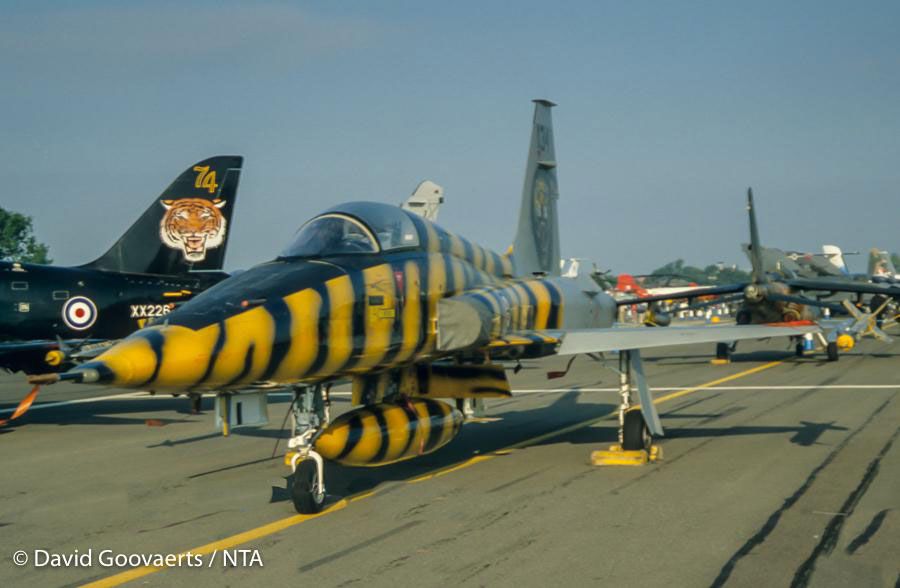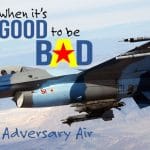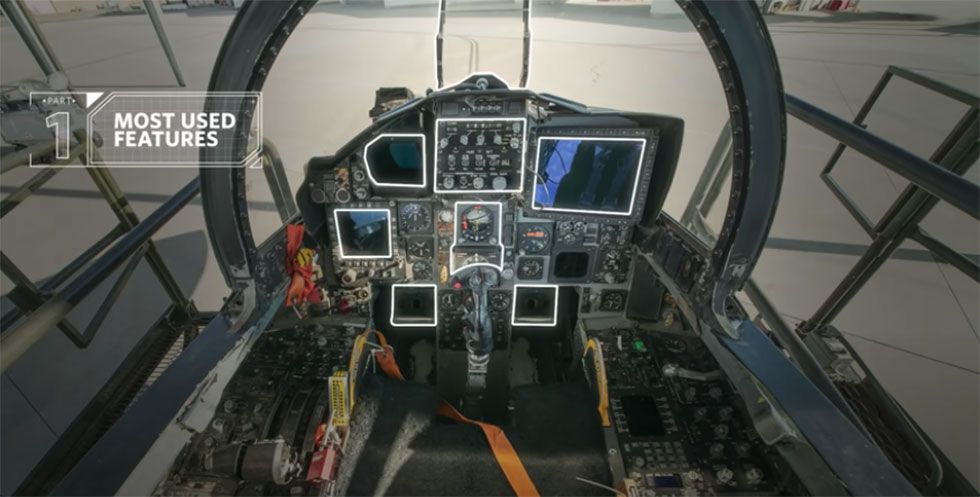“Once you have tasted flight, you will forever walk the earth with your eyes turned skyward, for there you have been, and there you will always long to return.”
― Leonardo da Vinci
One dream many children around the world have is to grow up to fly, most likely to be a fighter pilot. The few who actually pursue that dream will spend years going through primary and advanced flight training. Then, once they receive aircraft assignments, they participate in even more specific training for that aircraft and its missions before they likely are assigned to a flight squadron. Once they are assigned to their units, their flight training really begins.
Pilots are flying about 17 hours per month. For fighter pilots, those 17 hours may be a round trip training flight to a live firing range to attack a training target. It could include hours of formation flying or even touch-and-go training.
To hone their air-to-air combat skills, these pilots fly against other fighter aircraft in mock air battles. This training may include locating and identifying an aircraft from beyond visual range, locking onto, and simulating a missile attack. Then there is training that involves two pilots going head-to-head, dancing through the air, maneuvering on each other to gain the advantage, and simulating the shootdown of an enemy aircraft. This training is essential but did not always have the backing of those in command.
During World War II, U.S. fighter pilots would dogfight with their adversaries in Europe and the Pacific in real life-or-death air combat. In the following years, pilots kept their edge, experiencing aerial combat victories in the Korean War as the U.S. armed services still had men with experience in head-to-head combat from World War II. In Korea, the American pilots flying F-86 Sabres faced Chinese pilots flying the MiG-15. American pilots dominated the sky and the U.S. experienced a victory ratio of 10:1, with 792 MiGs lost versus 78 Sabres.
Following the Korean War, the United States reduced its emphasis on air combat maneuvering due to the belief that daytime dogfighting was a thing of the past. The fighter jets of that era would include radars that would presumably put missiles onto their targets Beyond Visual Range (BVR). With this belief, less importance was placed on training pilots to dogfight.
During Vietnam, the very fast F-4 Phantom II, the primary fighter platform for the U.S., faced a nearly as fast, but much more nimble, MiG-21 Fishbed. The radar-guided missiles were very unreliable as most would not hit their target, especially at BVR, and some would not even release at all. Because of this lack of reliability of firing missiles at far-off targets, the pilots would need to maneuver behind the MiGs and fire multiple missiles simultaneously in order to have a chance at a kill. To make matters more difficult, the early F-4s did not have an internal gun. During the Vietnam War years of 1967-68, these circumstances created a less-than-spectacular US victory ratio of 2:1. Something needed to be done to increase pilot effectiveness during aerial combat.
In 1969, the United States Navy began the Advanced Fighter Weapons School, also known as Top Gun. Seeing the Navy’s success, in 1972 the US Air Force followed with the USAF Weapons School. Since then, the United States has formed many adversary training units that are ready to mock battle US fighter pilots around the world.
Many other countries have their own adversary air units to train their pilots. There are a couple of air forces that contract either US military adversary units or commercial/contract adversary services. This list below includes several countries that once had or still do have their own adversary air training units or contract the services directly.
United States
US Air Force
64th and 18th Aggressor Squadron (AGRS)
The Air Force equivalent to the Navy’s Top Gun is the USAF Weapons School based at Nellis Air Force Base in Nevada. The unit would be named the 64th Aggressor Squadron, nicknamed the “Aggressors”, and would be equipped with T-38 Talons and F-5 Tiger IIs to train their pilots in aerial combat. The other USAF AGRS is the 18th Squadron nicknamed the “Blue Foxes”. Though the USAF aggressor squadron training was too late to make a difference during Vietnam, when pilots did meet enemy aircraft, they swore by the aerial combat tactics they had been taught.
Over the coming decades as the Cold War continued, aggressor units adopted Soviet-style tactics and even secretly acquired Russian fighters to further enhance pilot training. The adversarial training schools would become experts in the way the Soviet Union used air combat tactics in conjunction with ground operations. The US jets were painted to mimic the Russian aircraft and even the pilots would wear uniforms to immerse themselves into the aggressor roles.
The Air Force continued to develop its programs like Red Flag, a large-scale exercise that gave pilots experience with operating in huge air operations with many different elements. The training was so successful that over the 40 year period of the F-15‘s service it has racked up more than 100 dogfighting victories without a single loss. Today, the 64th AGRS fly F-16C Fighting Falcons, which are painted in Russian camouflage schemes.
US Marine Corps
VMFT-401 “SNIPERS”
The Snipers, a Marine Corps Reserve fighter squadron, is the only adversary unit in the Marine Corps. The squadron was activated in 1986 and initially flew F-21A Kfirs, an Israeli-built combat aircraft. Today, they are stationed at Marine Corps Air Station Yuma in Arizona and currently operate F-5E Tiger IIs. Besides adversary air for training exercises, VMFT-401 also helps train new Marine Corps F/A-18 Hornet pilots. VMFT-401 pilots are reserve Marines and many are commercial airline pilots. They are experienced, highly trained, prior active duty Marine pilots and are experts in air combat tactics.
US Navy
PMA-226, VFC-12, VFC-13, and VFC-111
The three adversarial training units for the United States Navy are VFC-12 Fighting Omars, VFC-13 Saints, and VFC-111 Sundowners. Both -12 and -13 squadrons have flown both the A-4 Skyhawk and the F/A-18 Hornet. VFC-111 has only operated the F-5E Tiger II.
NAVAIR’s PMA-226 manages and supports specialized and proven platforms and systems including 16 aircraft types like the T-38, H-72, X-26, U-6, O-2, and sundowning/sundown inventories of H-3, A-4, and more from three physical locations. PMA-226’s Adversary Team is responsible for the overall management of two Adversary platforms, which are used primarily for air-to-air training: 44 x F-5 N/Fs and 14 x F-16 A/Bs. PMA-226’s CAS Team is also responsible for the management of Contractor Owned / Contractor Operated (COCO) aircraft support to the Fleet and acquisition community.
VFC-12 has been assigned to Naval Air Station Oceana at Virginia Beach, Virginia since 1975. Originally designated VC-12 when established in 1943, they were a fighter squadron flying aboard the USS Card in the western Pacific. They flew the F4F Wildcat and TBM-1 Avenger over the Pacific Theater until the Card’s homeport was reassigned to Norfolk, at which time they began to fly combat missions in the Atlantic Theater.
VFC-13 was activated in 1973 at NAS New Orleans. Its first assigned aircraft was the F-8 Crusader and then in 1974 transitioned to the A-4 Skyhawk. In 1996, VFC-13 transferred to NAS Fallon and also switched to the F-5E Tiger II. VFC-13 provides adversarial training for both the Navy and Marine Corps squadrons, carrier wings, and USAF units.
VFC-111’s nickname is the Sundowners and is located at NAS Key West. They provide adversary air services and dissimilar air combat training, flying the F-5N Tiger IIs. Originally a detachment of VFC-13 established in 2005, VFC-111 became a full-time squadron in 2006.
Canada
419 Tactical Fighter Training Squadron
The Royal Canadian Air Force was established in 1924. They have 391 aircraft, which includes the CF-18 Hornet, a multi-role fighter variation of the United States’ F-18. To hone the skills of the RCAF fighter pilots, the 419 Tactical Fighter Squadron provides advanced tactical fighter training flying CT-155 Hawk trainers. The squadron was disbanded in 1995 but reactivated on July 23, 2000, and is still active today.
China
Flight Test and Training Centre (FTTC)
There is not a lot of information available on China’s training program. The aggressor combat simulation squadron for China’s People’s Liberation Army Air Force is called the Flight Test and Training Center (FTTC). The FTTC can be traced back to 1953 but was officially established in 1987. They have 3 regiments that simulate enemy aircraft, which is mostly Western aircraft. They fly Su-30MKK, J-10, J-7, J-8, and JL-9 fighters to simulate different enemy aircraft. They have shared training exercises with Russian and Pakistan Air Force aggressor training programs.
Japan
Tactical Fighter Training Group
Activated in October 2000, Japan’s Air Self-Defense Force’s aggressor unit is the Tactical Fighter Training Group (hikoukyoudougu). It is part of the Air Tactics Development Wing and fly the Mitsubishi F-15J/DJ and the Kawasaki T-4 as its aggressor aircraft since 1992. The F-15J is a variation of the McDonnell Douglas F-15 Eagle and is produced by Mitsubishi Heavy Industries.
Israel
115 Squadron
Originally the 115 Squadron was formed in 1948 as a photo-reconnaissance unit flying the Mosquito PR16. Over the years, the 115 operated in various other roles other than an aggressor training unit. In 2005, the 115 Squadron, also known as the Flying Dragons, would become an aggressor squadron tasked with emulating enemy forces and tactics to create scenarios as close to flying under enemy threats as possible. The 115 operate the F-16A as their aggressor aircraft.
Singapore
140 Squadron
Recently in 2020, Singapore established their first aggressor squadron with the 140 Squadron “Osprey.” In recent years, the Republic of Singapore Air Force have sought commercial adversary training options but also moved to develop their own domestic training tools. The 140 Squadron was originally established in 1970 as Singapore’s first air defense squadron flying refurbished Hawker Hunters. Today, the pilots of the 140 Squadron fly the F-16C/D Fighting Falcons as their aggressor aircraft.
Soviet Union
1521st Aviation Base
In the 1970s during the Cold War era, the Soviet Union became aware that the United States had set up Air Force and Navy aggressor units that utilized Soviet tactics and US aircraft similar to Soviet fighter jets to train the American pilots in aerial combat techniques. At the time, the F-15 Eagle was the premier air-to-air combat fighter. The Israelis used the air-to-air superiority F-15 and the knowledge of how to defeat MiGs to a superior advantage over Syrian MiG-23 and MiG-21. The Soviet Union realized they needed a faster jet with better weapons and to teach their own pilots to fly against Western tactics and aircraft. To be both superior in overall performance and with air-to-air missiles over the F-15, they developed three aircraft, the Su-27, MiG-25PD, and MiG-31. Beyond just the aircraft, the Soviet Union also needed to train its pilots on how to fly against American/Western pilots. As a result, they established the 1521st Aviation Base to provide their Aggressor training. The pilots of the 1521st flew the MiG-29 to closely simulate the F-15 capabilities. Paint designs applied to the MiG-29 aircraft would allow them to resemble the F-15.
With the collapse of the Soviet Union and the Russian Federation becoming very tight on money, the aggressor squadrons were disbanded. Since the collapse, there has not been an active Russian aggressor squadron.
Germany
JG73 “Steinhoff” squadron
Following the reunification of Germany in 1991, the German Air Force (Luftwaffe) inherited MiG-29 aircraft and the highly trained pilots from the East German Air Force. The Luftwaffe created a squadron with these pilots and aircraft called Jagdgeschwader (fighter squadron) 73. Having the Russian-built aircraft flown by very experienced pilots with Soviet flying tactics provided Germany and western militaries the opportunity to fly against the real thing.
Norway
Norwegian Air Force 336th squadron
Formed in 1949, the 336 Skvadron (Squadron) was the first squadron in Royal Norwegian Air Force (RNoAF) to be assigned their first fighter jet, the Vampire Mk.5. Over the decades, the 336th transitioned from the Mk.5 to the F-84, F-5, and eventually the F-16. Between 1985 until it was disbanded in 1999, the 336 Skvadron also performed aggressor roles and Dissimilar air combat training (DACT).
United Kingdom
No. 100 Squadron
Established in February 1917 as a night bombing unit, No. 100 is one of Great Britain’s aggressor squadrons. They provide many different training missions for British pilots, one being as a target tower. They fly the Hawk T1 for their adversary squadron role during DACT.
Commercial/Contracted Adversary Services
Most countries have some military fighter pilot program but many cannot afford to supply their own internal aggressor training. The cost to fly and maintain aircraft is very significant, as is the wear and tear on the aircraft. Additional flight hours for training cause a drain on the life of any type of jet. Keeping hours off the United States’ active wartime fleet airframes is critical to the jets being available in the event of an international conflict. To ensure pilots are trained while cutting down on cost, militaries around the world have put more emphasis on using commercial/contracted adversary services.
Today, the torch of the Adversary Air training program has been handed to commercial operators who fly former combat jets. Tactical Air Support (TacAir), Draken International, Airborne Tactical Advantage Company (ATAC), Top Aces (formerly Discovery Air Defence in Canada), Air USA, and a host of new entrants into this market own between 350 and 400 former wartime jets ready to fill the contracted air services demand from USN, USMC, and USAF. These jets range from US-made F-5, F-16, and A-4s, to foreign-built Mirage F-1s, Cheetahs, L-159s, F-21 Kfirs, Hawker Hunters, and even MiG aircraft.
What it means to the future of air combat operations
Current US DoD contracts and RFQs in place will support contracted air services training for the next decade and will continue to grow in both size and scope. As warfare continues to evolve, so too will the threats from foreign aircraft manufacturers. These will include additional stealth, jamming, radar, and weapons, which US pilots must learn to both cope with and eliminate. By contracting the red air training to companies who privately own, operate, and advance these 3rd and 4th generation platforms, the US can constantly address pilot training shortfalls all while saving money.
How Duotech is helping the Contracted Adversary Companies
Fighter squadrons face shortfalls in AdAir for combat training due to budgetary shortages and a lack of truly advanced threat replication. Duotech is providing low cost but highly capable RADAR solutions that represent current threat capabilities. Jets equipped with the Nemesis RADAR are the best AdAir solution in the market today, with an unrivaled combination of performance and growth potential. With the Nemesis, Duotech Services has designed a purpose-built RADAR to support the AdAir market by presenting a solution that:
- Highly capable of utilizing modern RADAR techniques
- Is able to quickly add additional RADAR capabilities to meet AdAir training requirements
- Can generate threat replication via unclassified and classified means
- Delivers the most sustainable and maintainable RADAR system for the application
Below, we are sharing videos that highlight different aggressor training, which includes F-5 Tiger II, the F-14, and F-1.
AGGRESSOR TRAINING (Dissimilar Air Combat Training) VIDEOS







